HLTENN012: Implement and Monitor Care for Chronic Health Issues
VerifiedAdded on 2022/12/26
|16
|4271
|1
Homework Assignment
AI Summary
This assignment solution for HLTENN012 focuses on implementing and monitoring care for individuals with chronic health problems. It begins with an overview of key presenting features and clinical manifestations of various chronic conditions such as asthma, COPD, chronic pain, renal failure, heart failure, diabetes, eczema, and neurological disorders. The document then explores community-based care services available in Australia, national health priority areas, and clinical features distinguishing between temporary and permanent tracheostomies. It includes tables summarizing concepts and models of chronic health care, the social, emotional, physical, psychological, and financial impacts of chronic diseases, common sites for cancer development, and life variables affecting health. Furthermore, the assignment addresses strategies to manage chronic diseases, rehabilitation techniques, and equipment. Part B applies the concepts to a case study, discussing community-based care services, questions for a patient's family, health education, and the enrolled nurse's responses to patient needs, including strategies for patient self-management.
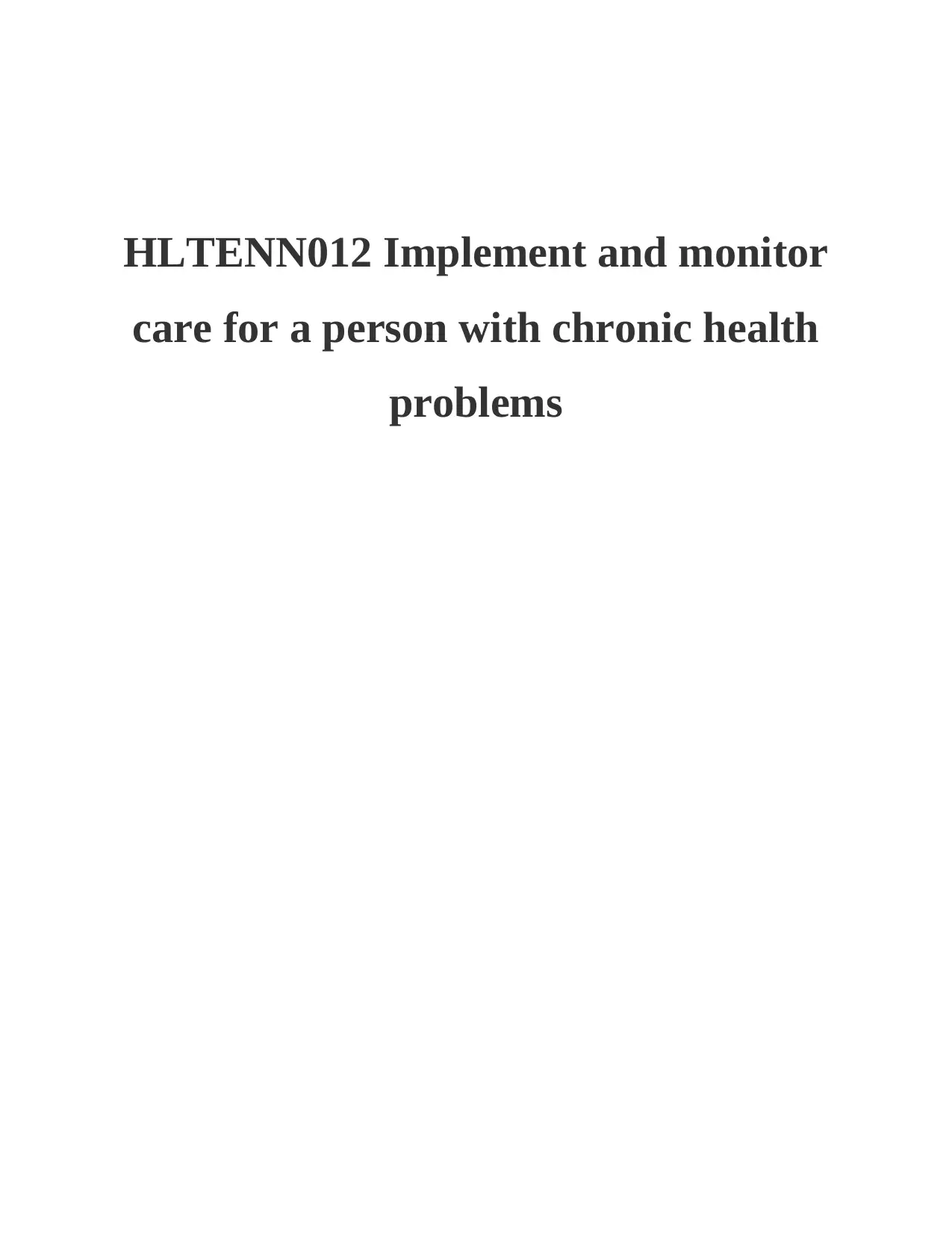
HLTENN012 Implement and monitor
care for a person with chronic health
problems
care for a person with chronic health
problems
Paraphrase This Document
Need a fresh take? Get an instant paraphrase of this document with our AI Paraphraser
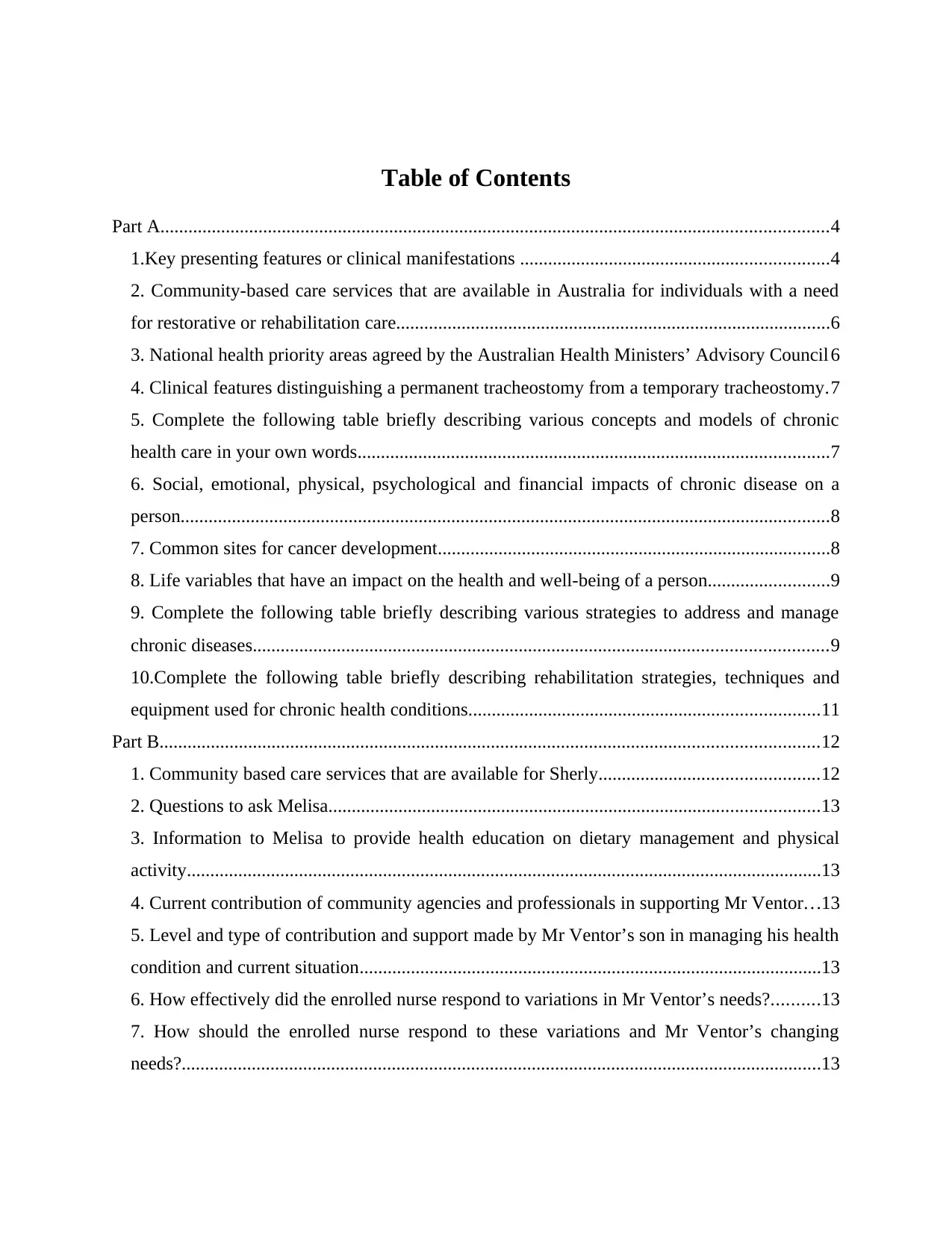
Table of Contents
Part A...............................................................................................................................................4
1.Key presenting features or clinical manifestations ..................................................................4
2. Community-based care services that are available in Australia for individuals with a need
for restorative or rehabilitation care.............................................................................................6
3. National health priority areas agreed by the Australian Health Ministers’ Advisory Council 6
4. Clinical features distinguishing a permanent tracheostomy from a temporary tracheostomy.7
5. Complete the following table briefly describing various concepts and models of chronic
health care in your own words.....................................................................................................7
6. Social, emotional, physical, psychological and financial impacts of chronic disease on a
person...........................................................................................................................................8
7. Common sites for cancer development....................................................................................8
8. Life variables that have an impact on the health and well-being of a person..........................9
9. Complete the following table briefly describing various strategies to address and manage
chronic diseases...........................................................................................................................9
10.Complete the following table briefly describing rehabilitation strategies, techniques and
equipment used for chronic health conditions...........................................................................11
Part B.............................................................................................................................................12
1. Community based care services that are available for Sherly...............................................12
2. Questions to ask Melisa.........................................................................................................13
3. Information to Melisa to provide health education on dietary management and physical
activity........................................................................................................................................13
4. Current contribution of community agencies and professionals in supporting Mr Ventor...13
5. Level and type of contribution and support made by Mr Ventor’s son in managing his health
condition and current situation...................................................................................................13
6. How effectively did the enrolled nurse respond to variations in Mr Ventor’s needs?..........13
7. How should the enrolled nurse respond to these variations and Mr Ventor’s changing
needs?.........................................................................................................................................13
Part A...............................................................................................................................................4
1.Key presenting features or clinical manifestations ..................................................................4
2. Community-based care services that are available in Australia for individuals with a need
for restorative or rehabilitation care.............................................................................................6
3. National health priority areas agreed by the Australian Health Ministers’ Advisory Council 6
4. Clinical features distinguishing a permanent tracheostomy from a temporary tracheostomy.7
5. Complete the following table briefly describing various concepts and models of chronic
health care in your own words.....................................................................................................7
6. Social, emotional, physical, psychological and financial impacts of chronic disease on a
person...........................................................................................................................................8
7. Common sites for cancer development....................................................................................8
8. Life variables that have an impact on the health and well-being of a person..........................9
9. Complete the following table briefly describing various strategies to address and manage
chronic diseases...........................................................................................................................9
10.Complete the following table briefly describing rehabilitation strategies, techniques and
equipment used for chronic health conditions...........................................................................11
Part B.............................................................................................................................................12
1. Community based care services that are available for Sherly...............................................12
2. Questions to ask Melisa.........................................................................................................13
3. Information to Melisa to provide health education on dietary management and physical
activity........................................................................................................................................13
4. Current contribution of community agencies and professionals in supporting Mr Ventor...13
5. Level and type of contribution and support made by Mr Ventor’s son in managing his health
condition and current situation...................................................................................................13
6. How effectively did the enrolled nurse respond to variations in Mr Ventor’s needs?..........13
7. How should the enrolled nurse respond to these variations and Mr Ventor’s changing
needs?.........................................................................................................................................13
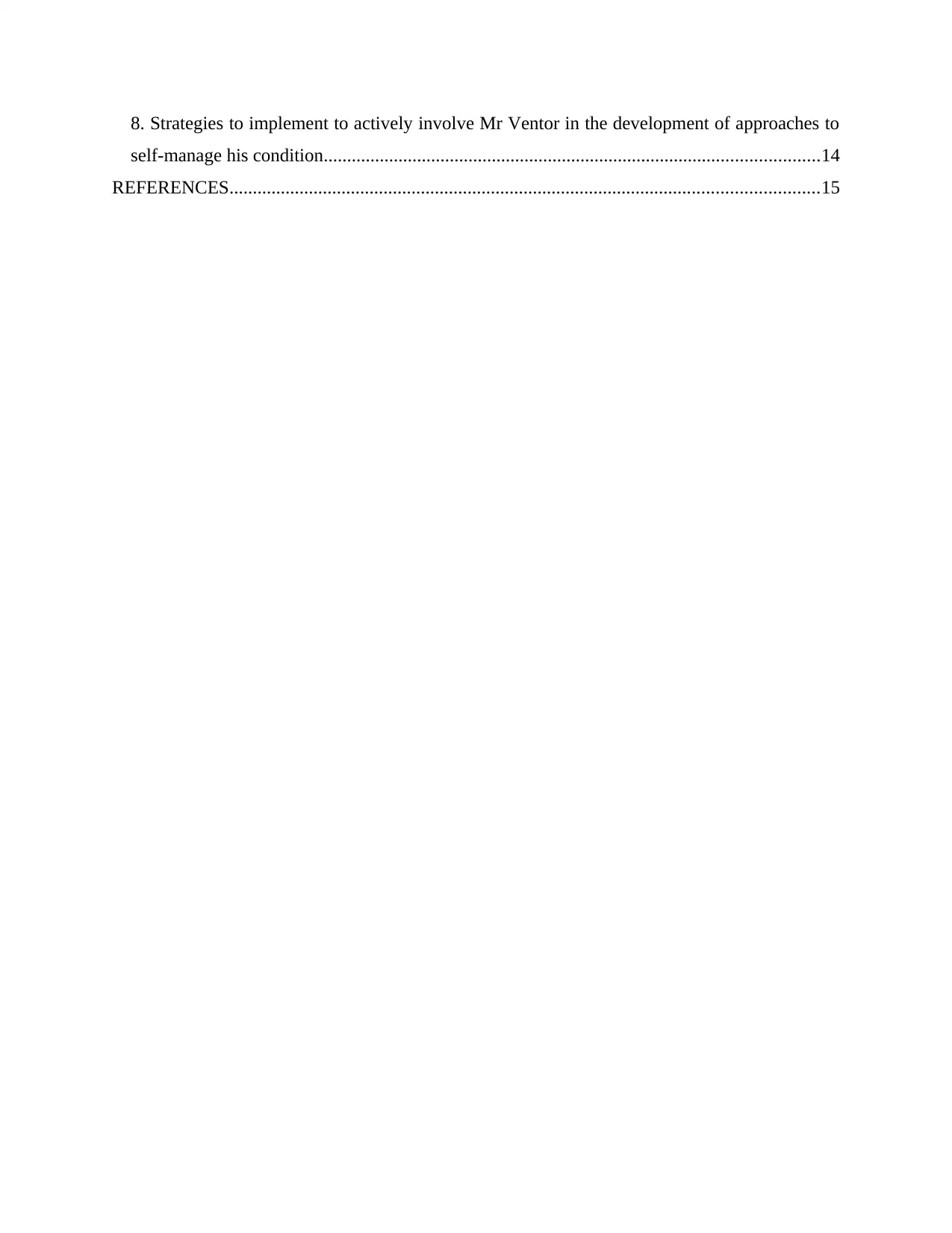
8. Strategies to implement to actively involve Mr Ventor in the development of approaches to
self-manage his condition..........................................................................................................14
REFERENCES..............................................................................................................................15
self-manage his condition..........................................................................................................14
REFERENCES..............................................................................................................................15
⊘ This is a preview!⊘
Do you want full access?
Subscribe today to unlock all pages.

Trusted by 1+ million students worldwide
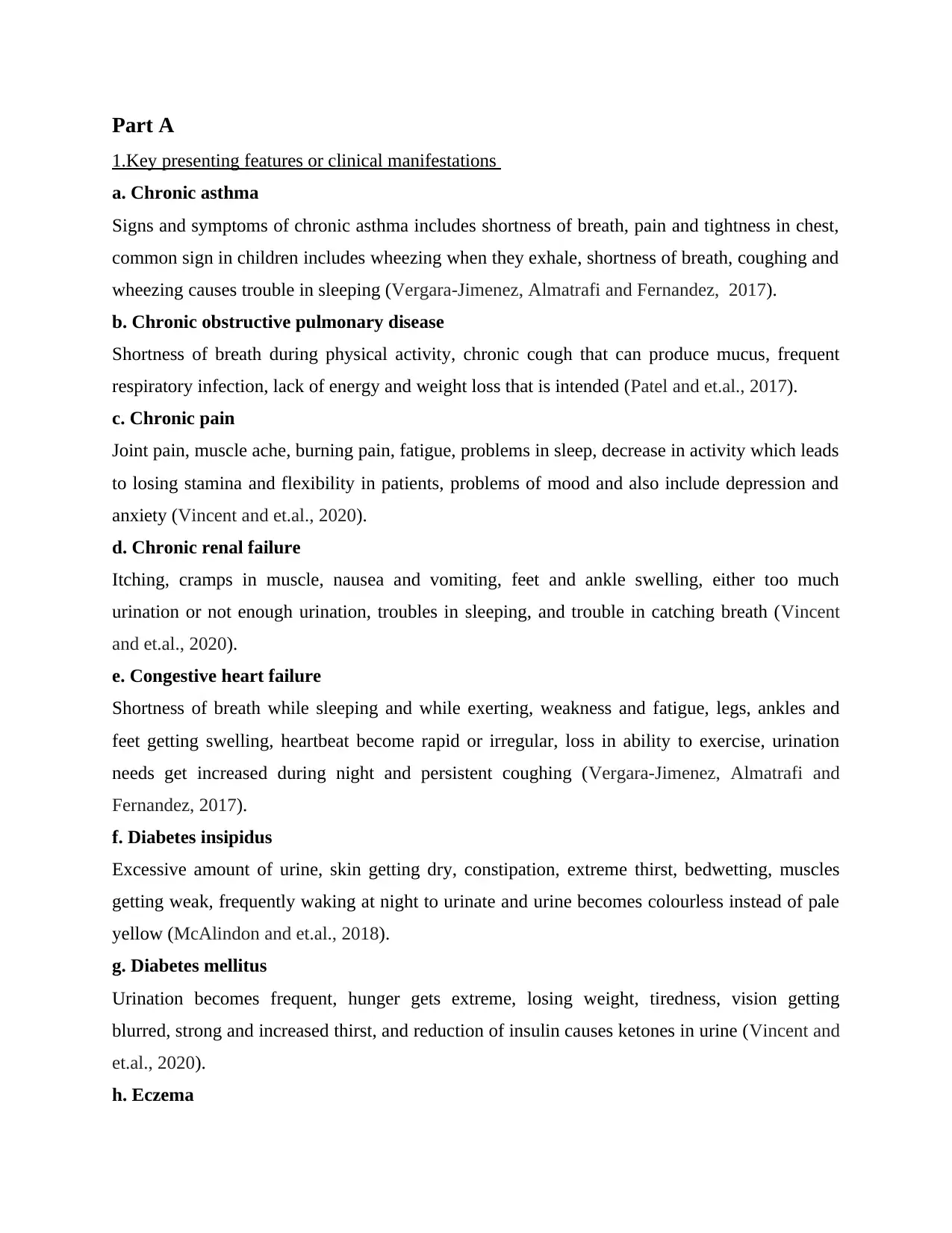
Part A
1.Key presenting features or clinical manifestations
a. Chronic asthma
Signs and symptoms of chronic asthma includes shortness of breath, pain and tightness in chest,
common sign in children includes wheezing when they exhale, shortness of breath, coughing and
wheezing causes trouble in sleeping (Vergara-Jimenez, Almatrafi and Fernandez, 2017).
b. Chronic obstructive pulmonary disease
Shortness of breath during physical activity, chronic cough that can produce mucus, frequent
respiratory infection, lack of energy and weight loss that is intended (Patel and et.al., 2017).
c. Chronic pain
Joint pain, muscle ache, burning pain, fatigue, problems in sleep, decrease in activity which leads
to losing stamina and flexibility in patients, problems of mood and also include depression and
anxiety (Vincent and et.al., 2020).
d. Chronic renal failure
Itching, cramps in muscle, nausea and vomiting, feet and ankle swelling, either too much
urination or not enough urination, troubles in sleeping, and trouble in catching breath (Vincent
and et.al., 2020).
e. Congestive heart failure
Shortness of breath while sleeping and while exerting, weakness and fatigue, legs, ankles and
feet getting swelling, heartbeat become rapid or irregular, loss in ability to exercise, urination
needs get increased during night and persistent coughing (Vergara-Jimenez, Almatrafi and
Fernandez, 2017).
f. Diabetes insipidus
Excessive amount of urine, skin getting dry, constipation, extreme thirst, bedwetting, muscles
getting weak, frequently waking at night to urinate and urine becomes colourless instead of pale
yellow (McAlindon and et.al., 2018).
g. Diabetes mellitus
Urination becomes frequent, hunger gets extreme, losing weight, tiredness, vision getting
blurred, strong and increased thirst, and reduction of insulin causes ketones in urine (Vincent and
et.al., 2020).
h. Eczema
1.Key presenting features or clinical manifestations
a. Chronic asthma
Signs and symptoms of chronic asthma includes shortness of breath, pain and tightness in chest,
common sign in children includes wheezing when they exhale, shortness of breath, coughing and
wheezing causes trouble in sleeping (Vergara-Jimenez, Almatrafi and Fernandez, 2017).
b. Chronic obstructive pulmonary disease
Shortness of breath during physical activity, chronic cough that can produce mucus, frequent
respiratory infection, lack of energy and weight loss that is intended (Patel and et.al., 2017).
c. Chronic pain
Joint pain, muscle ache, burning pain, fatigue, problems in sleep, decrease in activity which leads
to losing stamina and flexibility in patients, problems of mood and also include depression and
anxiety (Vincent and et.al., 2020).
d. Chronic renal failure
Itching, cramps in muscle, nausea and vomiting, feet and ankle swelling, either too much
urination or not enough urination, troubles in sleeping, and trouble in catching breath (Vincent
and et.al., 2020).
e. Congestive heart failure
Shortness of breath while sleeping and while exerting, weakness and fatigue, legs, ankles and
feet getting swelling, heartbeat become rapid or irregular, loss in ability to exercise, urination
needs get increased during night and persistent coughing (Vergara-Jimenez, Almatrafi and
Fernandez, 2017).
f. Diabetes insipidus
Excessive amount of urine, skin getting dry, constipation, extreme thirst, bedwetting, muscles
getting weak, frequently waking at night to urinate and urine becomes colourless instead of pale
yellow (McAlindon and et.al., 2018).
g. Diabetes mellitus
Urination becomes frequent, hunger gets extreme, losing weight, tiredness, vision getting
blurred, strong and increased thirst, and reduction of insulin causes ketones in urine (Vincent and
et.al., 2020).
h. Eczema
Paraphrase This Document
Need a fresh take? Get an instant paraphrase of this document with our AI Paraphraser
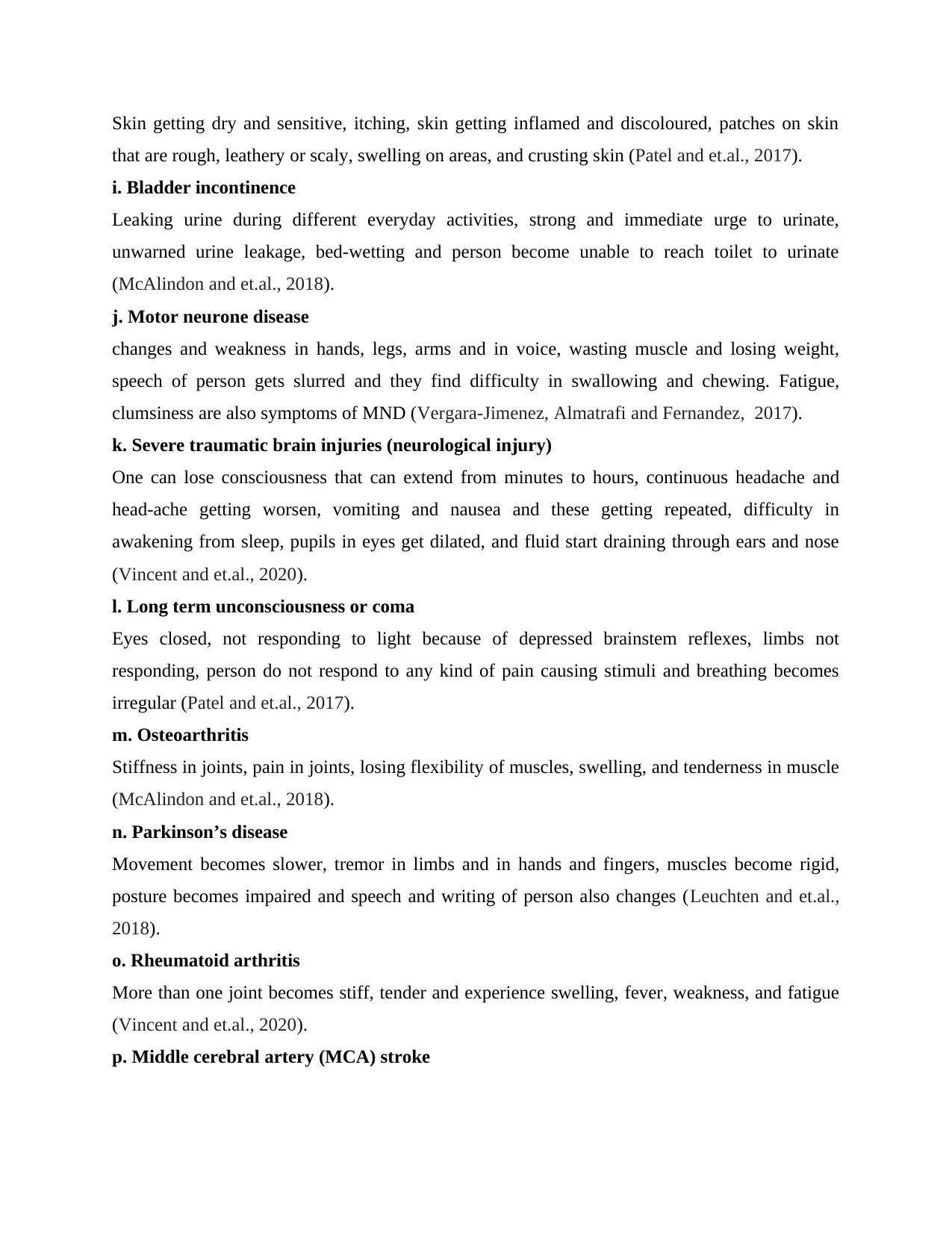
Skin getting dry and sensitive, itching, skin getting inflamed and discoloured, patches on skin
that are rough, leathery or scaly, swelling on areas, and crusting skin (Patel and et.al., 2017).
i. Bladder incontinence
Leaking urine during different everyday activities, strong and immediate urge to urinate,
unwarned urine leakage, bed-wetting and person become unable to reach toilet to urinate
(McAlindon and et.al., 2018).
j. Motor neurone disease
changes and weakness in hands, legs, arms and in voice, wasting muscle and losing weight,
speech of person gets slurred and they find difficulty in swallowing and chewing. Fatigue,
clumsiness are also symptoms of MND (Vergara-Jimenez, Almatrafi and Fernandez, 2017).
k. Severe traumatic brain injuries (neurological injury)
One can lose consciousness that can extend from minutes to hours, continuous headache and
head-ache getting worsen, vomiting and nausea and these getting repeated, difficulty in
awakening from sleep, pupils in eyes get dilated, and fluid start draining through ears and nose
(Vincent and et.al., 2020).
l. Long term unconsciousness or coma
Eyes closed, not responding to light because of depressed brainstem reflexes, limbs not
responding, person do not respond to any kind of pain causing stimuli and breathing becomes
irregular (Patel and et.al., 2017).
m. Osteoarthritis
Stiffness in joints, pain in joints, losing flexibility of muscles, swelling, and tenderness in muscle
(McAlindon and et.al., 2018).
n. Parkinson’s disease
Movement becomes slower, tremor in limbs and in hands and fingers, muscles become rigid,
posture becomes impaired and speech and writing of person also changes (Leuchten and et.al.,
2018).
o. Rheumatoid arthritis
More than one joint becomes stiff, tender and experience swelling, fever, weakness, and fatigue
(Vincent and et.al., 2020).
p. Middle cerebral artery (MCA) stroke
that are rough, leathery or scaly, swelling on areas, and crusting skin (Patel and et.al., 2017).
i. Bladder incontinence
Leaking urine during different everyday activities, strong and immediate urge to urinate,
unwarned urine leakage, bed-wetting and person become unable to reach toilet to urinate
(McAlindon and et.al., 2018).
j. Motor neurone disease
changes and weakness in hands, legs, arms and in voice, wasting muscle and losing weight,
speech of person gets slurred and they find difficulty in swallowing and chewing. Fatigue,
clumsiness are also symptoms of MND (Vergara-Jimenez, Almatrafi and Fernandez, 2017).
k. Severe traumatic brain injuries (neurological injury)
One can lose consciousness that can extend from minutes to hours, continuous headache and
head-ache getting worsen, vomiting and nausea and these getting repeated, difficulty in
awakening from sleep, pupils in eyes get dilated, and fluid start draining through ears and nose
(Vincent and et.al., 2020).
l. Long term unconsciousness or coma
Eyes closed, not responding to light because of depressed brainstem reflexes, limbs not
responding, person do not respond to any kind of pain causing stimuli and breathing becomes
irregular (Patel and et.al., 2017).
m. Osteoarthritis
Stiffness in joints, pain in joints, losing flexibility of muscles, swelling, and tenderness in muscle
(McAlindon and et.al., 2018).
n. Parkinson’s disease
Movement becomes slower, tremor in limbs and in hands and fingers, muscles become rigid,
posture becomes impaired and speech and writing of person also changes (Leuchten and et.al.,
2018).
o. Rheumatoid arthritis
More than one joint becomes stiff, tender and experience swelling, fever, weakness, and fatigue
(Vincent and et.al., 2020).
p. Middle cerebral artery (MCA) stroke
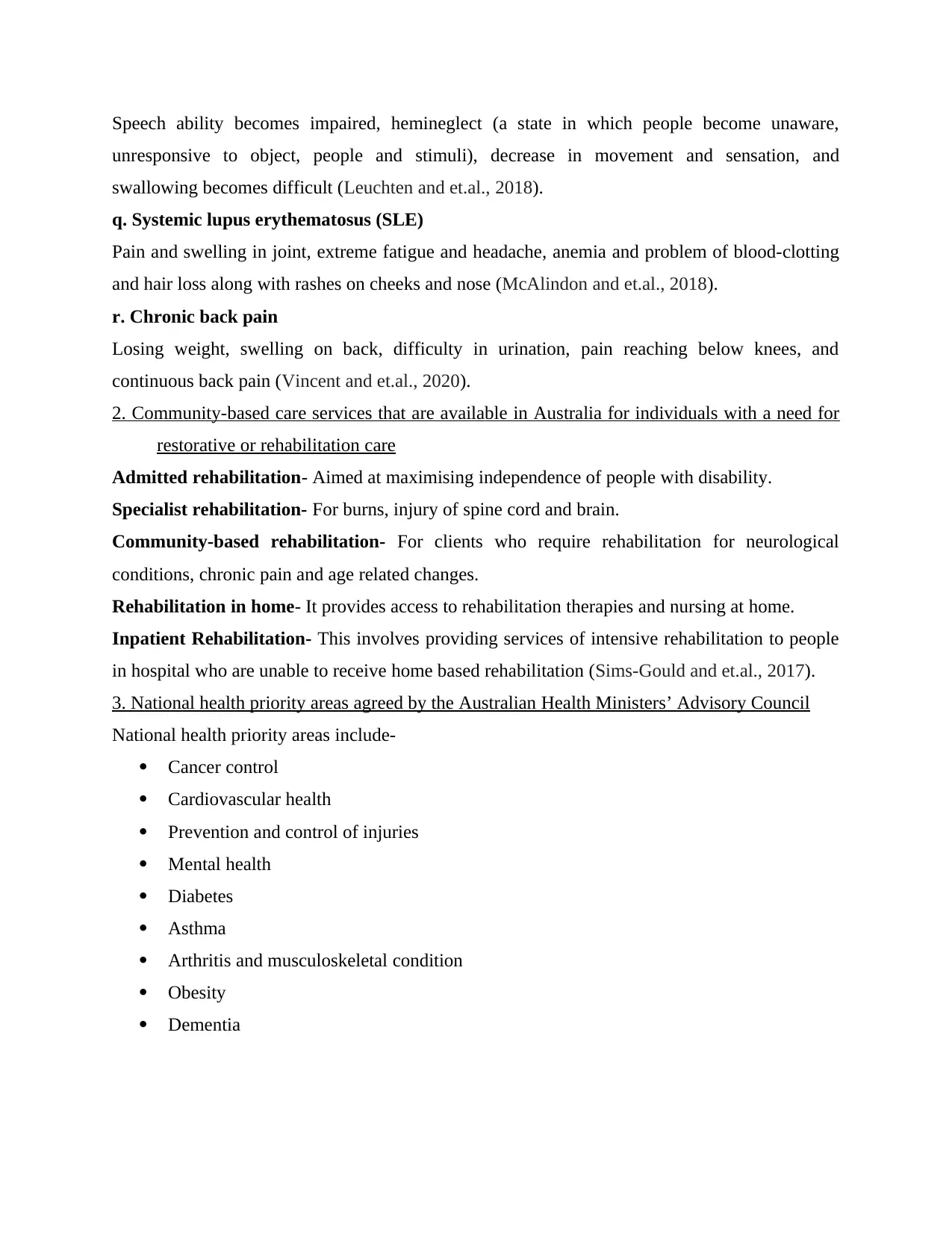
Speech ability becomes impaired, hemineglect (a state in which people become unaware,
unresponsive to object, people and stimuli), decrease in movement and sensation, and
swallowing becomes difficult (Leuchten and et.al., 2018).
q. Systemic lupus erythematosus (SLE)
Pain and swelling in joint, extreme fatigue and headache, anemia and problem of blood-clotting
and hair loss along with rashes on cheeks and nose (McAlindon and et.al., 2018).
r. Chronic back pain
Losing weight, swelling on back, difficulty in urination, pain reaching below knees, and
continuous back pain (Vincent and et.al., 2020).
2. Community-based care services that are available in Australia for individuals with a need for
restorative or rehabilitation care
Admitted rehabilitation- Aimed at maximising independence of people with disability.
Specialist rehabilitation- For burns, injury of spine cord and brain.
Community-based rehabilitation- For clients who require rehabilitation for neurological
conditions, chronic pain and age related changes.
Rehabilitation in home- It provides access to rehabilitation therapies and nursing at home.
Inpatient Rehabilitation- This involves providing services of intensive rehabilitation to people
in hospital who are unable to receive home based rehabilitation (Sims-Gould and et.al., 2017).
3. National health priority areas agreed by the Australian Health Ministers’ Advisory Council
National health priority areas include-
Cancer control
Cardiovascular health
Prevention and control of injuries
Mental health
Diabetes
Asthma
Arthritis and musculoskeletal condition
Obesity
Dementia
unresponsive to object, people and stimuli), decrease in movement and sensation, and
swallowing becomes difficult (Leuchten and et.al., 2018).
q. Systemic lupus erythematosus (SLE)
Pain and swelling in joint, extreme fatigue and headache, anemia and problem of blood-clotting
and hair loss along with rashes on cheeks and nose (McAlindon and et.al., 2018).
r. Chronic back pain
Losing weight, swelling on back, difficulty in urination, pain reaching below knees, and
continuous back pain (Vincent and et.al., 2020).
2. Community-based care services that are available in Australia for individuals with a need for
restorative or rehabilitation care
Admitted rehabilitation- Aimed at maximising independence of people with disability.
Specialist rehabilitation- For burns, injury of spine cord and brain.
Community-based rehabilitation- For clients who require rehabilitation for neurological
conditions, chronic pain and age related changes.
Rehabilitation in home- It provides access to rehabilitation therapies and nursing at home.
Inpatient Rehabilitation- This involves providing services of intensive rehabilitation to people
in hospital who are unable to receive home based rehabilitation (Sims-Gould and et.al., 2017).
3. National health priority areas agreed by the Australian Health Ministers’ Advisory Council
National health priority areas include-
Cancer control
Cardiovascular health
Prevention and control of injuries
Mental health
Diabetes
Asthma
Arthritis and musculoskeletal condition
Obesity
Dementia
⊘ This is a preview!⊘
Do you want full access?
Subscribe today to unlock all pages.

Trusted by 1+ million students worldwide
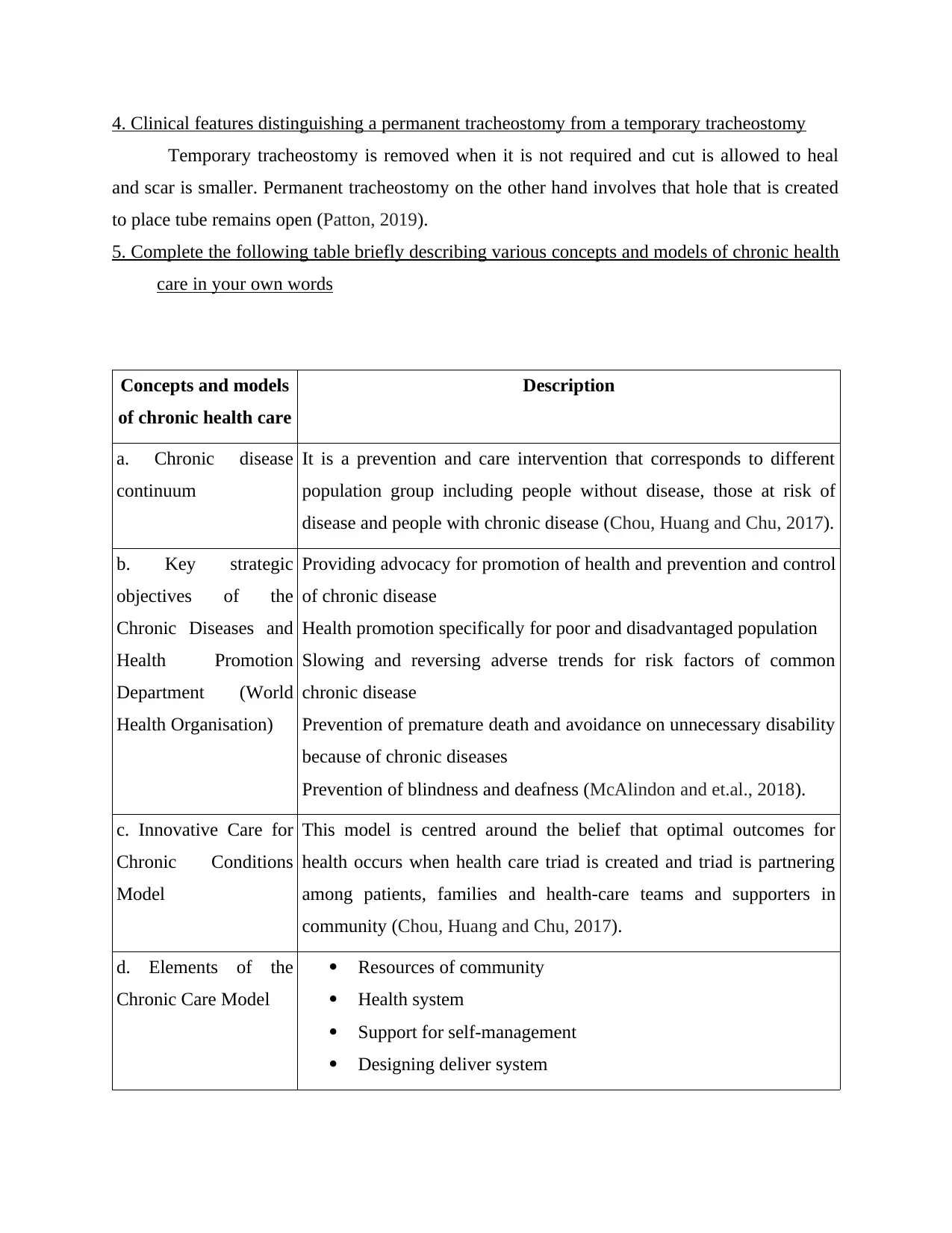
4. Clinical features distinguishing a permanent tracheostomy from a temporary tracheostomy
Temporary tracheostomy is removed when it is not required and cut is allowed to heal
and scar is smaller. Permanent tracheostomy on the other hand involves that hole that is created
to place tube remains open (Patton, 2019).
5. Complete the following table briefly describing various concepts and models of chronic health
care in your own words
Concepts and models
of chronic health care
Description
a. Chronic disease
continuum
It is a prevention and care intervention that corresponds to different
population group including people without disease, those at risk of
disease and people with chronic disease (Chou, Huang and Chu, 2017).
b. Key strategic
objectives of the
Chronic Diseases and
Health Promotion
Department (World
Health Organisation)
Providing advocacy for promotion of health and prevention and control
of chronic disease
Health promotion specifically for poor and disadvantaged population
Slowing and reversing adverse trends for risk factors of common
chronic disease
Prevention of premature death and avoidance on unnecessary disability
because of chronic diseases
Prevention of blindness and deafness (McAlindon and et.al., 2018).
c. Innovative Care for
Chronic Conditions
Model
This model is centred around the belief that optimal outcomes for
health occurs when health care triad is created and triad is partnering
among patients, families and health-care teams and supporters in
community (Chou, Huang and Chu, 2017).
d. Elements of the
Chronic Care Model
Resources of community
Health system
Support for self-management
Designing deliver system
Temporary tracheostomy is removed when it is not required and cut is allowed to heal
and scar is smaller. Permanent tracheostomy on the other hand involves that hole that is created
to place tube remains open (Patton, 2019).
5. Complete the following table briefly describing various concepts and models of chronic health
care in your own words
Concepts and models
of chronic health care
Description
a. Chronic disease
continuum
It is a prevention and care intervention that corresponds to different
population group including people without disease, those at risk of
disease and people with chronic disease (Chou, Huang and Chu, 2017).
b. Key strategic
objectives of the
Chronic Diseases and
Health Promotion
Department (World
Health Organisation)
Providing advocacy for promotion of health and prevention and control
of chronic disease
Health promotion specifically for poor and disadvantaged population
Slowing and reversing adverse trends for risk factors of common
chronic disease
Prevention of premature death and avoidance on unnecessary disability
because of chronic diseases
Prevention of blindness and deafness (McAlindon and et.al., 2018).
c. Innovative Care for
Chronic Conditions
Model
This model is centred around the belief that optimal outcomes for
health occurs when health care triad is created and triad is partnering
among patients, families and health-care teams and supporters in
community (Chou, Huang and Chu, 2017).
d. Elements of the
Chronic Care Model
Resources of community
Health system
Support for self-management
Designing deliver system
Paraphrase This Document
Need a fresh take? Get an instant paraphrase of this document with our AI Paraphraser
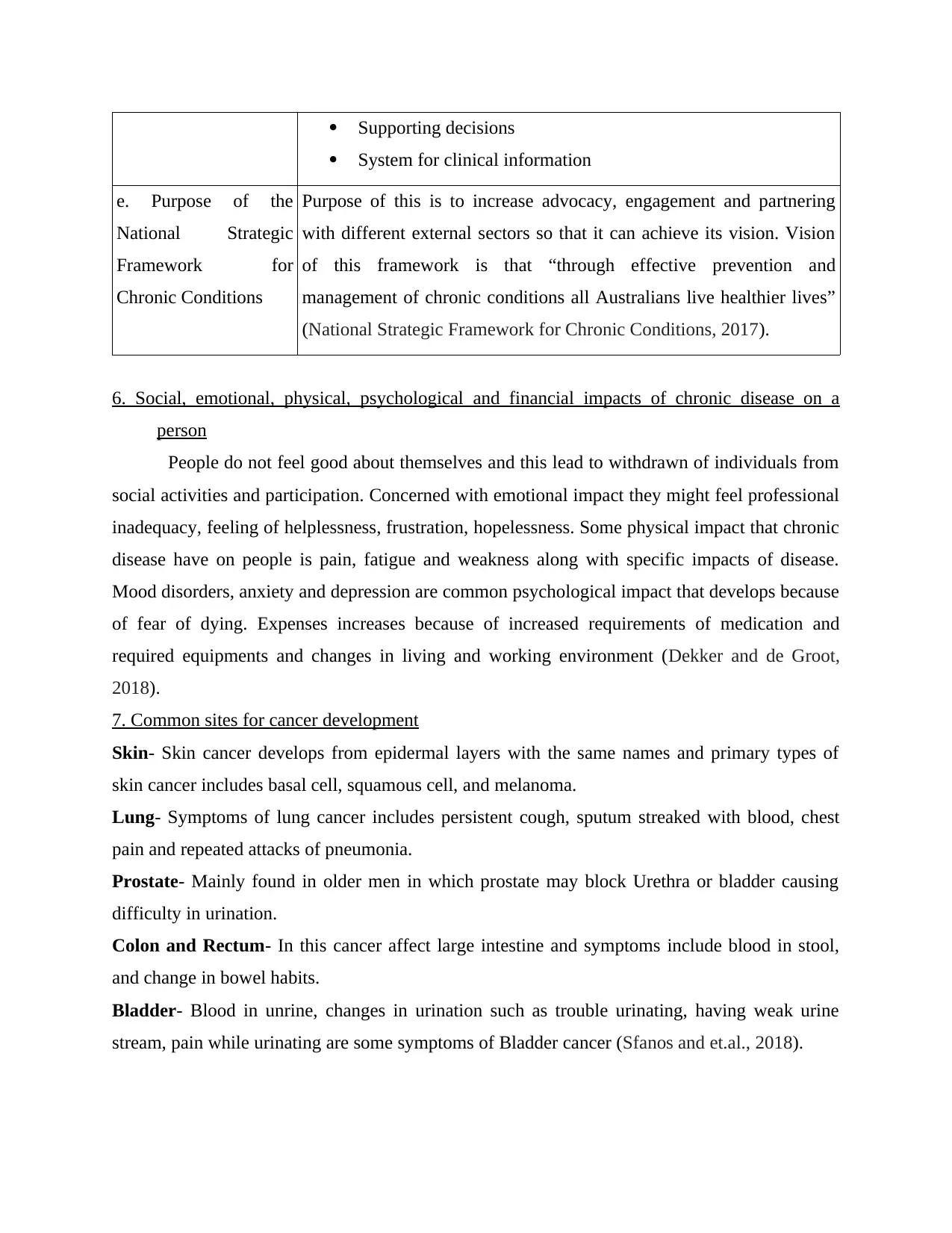
Supporting decisions
System for clinical information
e. Purpose of the
National Strategic
Framework for
Chronic Conditions
Purpose of this is to increase advocacy, engagement and partnering
with different external sectors so that it can achieve its vision. Vision
of this framework is that “through effective prevention and
management of chronic conditions all Australians live healthier lives”
(National Strategic Framework for Chronic Conditions, 2017).
6. Social, emotional, physical, psychological and financial impacts of chronic disease on a
person
People do not feel good about themselves and this lead to withdrawn of individuals from
social activities and participation. Concerned with emotional impact they might feel professional
inadequacy, feeling of helplessness, frustration, hopelessness. Some physical impact that chronic
disease have on people is pain, fatigue and weakness along with specific impacts of disease.
Mood disorders, anxiety and depression are common psychological impact that develops because
of fear of dying. Expenses increases because of increased requirements of medication and
required equipments and changes in living and working environment (Dekker and de Groot,
2018).
7. Common sites for cancer development
Skin- Skin cancer develops from epidermal layers with the same names and primary types of
skin cancer includes basal cell, squamous cell, and melanoma.
Lung- Symptoms of lung cancer includes persistent cough, sputum streaked with blood, chest
pain and repeated attacks of pneumonia.
Prostate- Mainly found in older men in which prostate may block Urethra or bladder causing
difficulty in urination.
Colon and Rectum- In this cancer affect large intestine and symptoms include blood in stool,
and change in bowel habits.
Bladder- Blood in unrine, changes in urination such as trouble urinating, having weak urine
stream, pain while urinating are some symptoms of Bladder cancer (Sfanos and et.al., 2018).
System for clinical information
e. Purpose of the
National Strategic
Framework for
Chronic Conditions
Purpose of this is to increase advocacy, engagement and partnering
with different external sectors so that it can achieve its vision. Vision
of this framework is that “through effective prevention and
management of chronic conditions all Australians live healthier lives”
(National Strategic Framework for Chronic Conditions, 2017).
6. Social, emotional, physical, psychological and financial impacts of chronic disease on a
person
People do not feel good about themselves and this lead to withdrawn of individuals from
social activities and participation. Concerned with emotional impact they might feel professional
inadequacy, feeling of helplessness, frustration, hopelessness. Some physical impact that chronic
disease have on people is pain, fatigue and weakness along with specific impacts of disease.
Mood disorders, anxiety and depression are common psychological impact that develops because
of fear of dying. Expenses increases because of increased requirements of medication and
required equipments and changes in living and working environment (Dekker and de Groot,
2018).
7. Common sites for cancer development
Skin- Skin cancer develops from epidermal layers with the same names and primary types of
skin cancer includes basal cell, squamous cell, and melanoma.
Lung- Symptoms of lung cancer includes persistent cough, sputum streaked with blood, chest
pain and repeated attacks of pneumonia.
Prostate- Mainly found in older men in which prostate may block Urethra or bladder causing
difficulty in urination.
Colon and Rectum- In this cancer affect large intestine and symptoms include blood in stool,
and change in bowel habits.
Bladder- Blood in unrine, changes in urination such as trouble urinating, having weak urine
stream, pain while urinating are some symptoms of Bladder cancer (Sfanos and et.al., 2018).
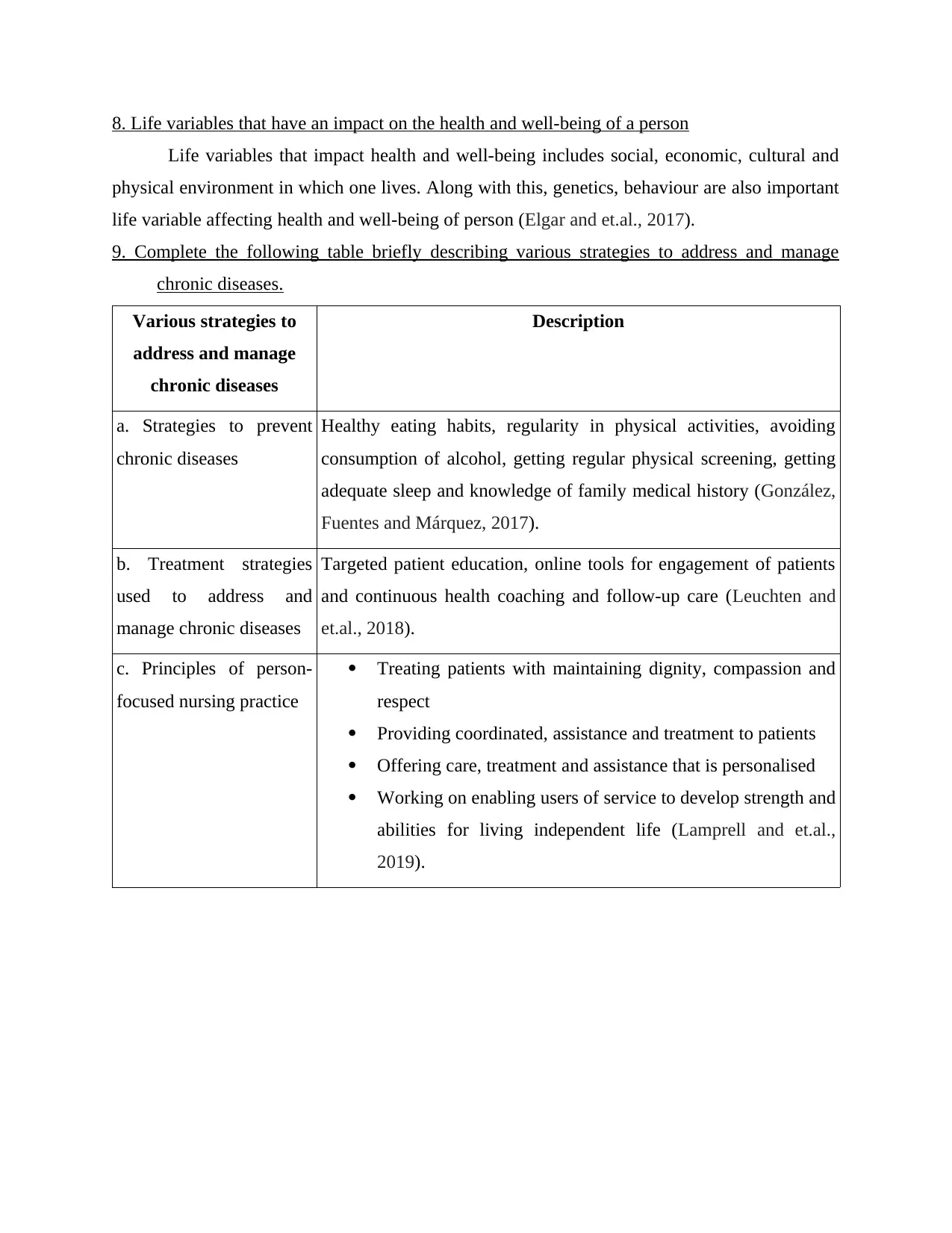
8. Life variables that have an impact on the health and well-being of a person
Life variables that impact health and well-being includes social, economic, cultural and
physical environment in which one lives. Along with this, genetics, behaviour are also important
life variable affecting health and well-being of person (Elgar and et.al., 2017).
9. Complete the following table briefly describing various strategies to address and manage
chronic diseases.
Various strategies to
address and manage
chronic diseases
Description
a. Strategies to prevent
chronic diseases
Healthy eating habits, regularity in physical activities, avoiding
consumption of alcohol, getting regular physical screening, getting
adequate sleep and knowledge of family medical history (González,
Fuentes and Márquez, 2017).
b. Treatment strategies
used to address and
manage chronic diseases
Targeted patient education, online tools for engagement of patients
and continuous health coaching and follow-up care (Leuchten and
et.al., 2018).
c. Principles of person-
focused nursing practice
Treating patients with maintaining dignity, compassion and
respect
Providing coordinated, assistance and treatment to patients
Offering care, treatment and assistance that is personalised
Working on enabling users of service to develop strength and
abilities for living independent life (Lamprell and et.al.,
2019).
Life variables that impact health and well-being includes social, economic, cultural and
physical environment in which one lives. Along with this, genetics, behaviour are also important
life variable affecting health and well-being of person (Elgar and et.al., 2017).
9. Complete the following table briefly describing various strategies to address and manage
chronic diseases.
Various strategies to
address and manage
chronic diseases
Description
a. Strategies to prevent
chronic diseases
Healthy eating habits, regularity in physical activities, avoiding
consumption of alcohol, getting regular physical screening, getting
adequate sleep and knowledge of family medical history (González,
Fuentes and Márquez, 2017).
b. Treatment strategies
used to address and
manage chronic diseases
Targeted patient education, online tools for engagement of patients
and continuous health coaching and follow-up care (Leuchten and
et.al., 2018).
c. Principles of person-
focused nursing practice
Treating patients with maintaining dignity, compassion and
respect
Providing coordinated, assistance and treatment to patients
Offering care, treatment and assistance that is personalised
Working on enabling users of service to develop strength and
abilities for living independent life (Lamprell and et.al.,
2019).
⊘ This is a preview!⊘
Do you want full access?
Subscribe today to unlock all pages.

Trusted by 1+ million students worldwide
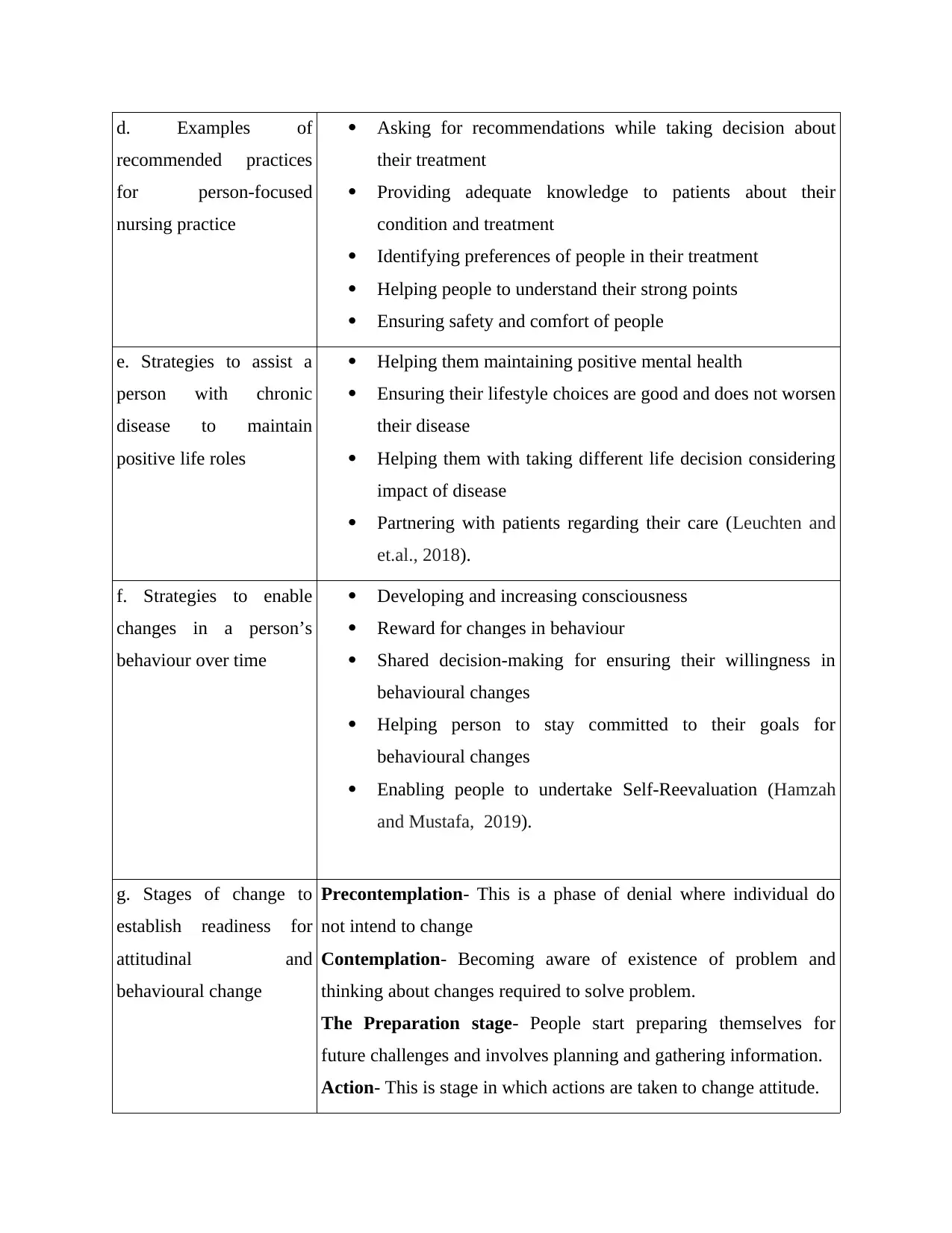
d. Examples of
recommended practices
for person-focused
nursing practice
Asking for recommendations while taking decision about
their treatment
Providing adequate knowledge to patients about their
condition and treatment
Identifying preferences of people in their treatment
Helping people to understand their strong points
Ensuring safety and comfort of people
e. Strategies to assist a
person with chronic
disease to maintain
positive life roles
Helping them maintaining positive mental health
Ensuring their lifestyle choices are good and does not worsen
their disease
Helping them with taking different life decision considering
impact of disease
Partnering with patients regarding their care (Leuchten and
et.al., 2018).
f. Strategies to enable
changes in a person’s
behaviour over time
Developing and increasing consciousness
Reward for changes in behaviour
Shared decision-making for ensuring their willingness in
behavioural changes
Helping person to stay committed to their goals for
behavioural changes
Enabling people to undertake Self-Reevaluation (Hamzah
and Mustafa, 2019).
g. Stages of change to
establish readiness for
attitudinal and
behavioural change
Precontemplation- This is a phase of denial where individual do
not intend to change
Contemplation- Becoming aware of existence of problem and
thinking about changes required to solve problem.
The Preparation stage- People start preparing themselves for
future challenges and involves planning and gathering information.
Action- This is stage in which actions are taken to change attitude.
recommended practices
for person-focused
nursing practice
Asking for recommendations while taking decision about
their treatment
Providing adequate knowledge to patients about their
condition and treatment
Identifying preferences of people in their treatment
Helping people to understand their strong points
Ensuring safety and comfort of people
e. Strategies to assist a
person with chronic
disease to maintain
positive life roles
Helping them maintaining positive mental health
Ensuring their lifestyle choices are good and does not worsen
their disease
Helping them with taking different life decision considering
impact of disease
Partnering with patients regarding their care (Leuchten and
et.al., 2018).
f. Strategies to enable
changes in a person’s
behaviour over time
Developing and increasing consciousness
Reward for changes in behaviour
Shared decision-making for ensuring their willingness in
behavioural changes
Helping person to stay committed to their goals for
behavioural changes
Enabling people to undertake Self-Reevaluation (Hamzah
and Mustafa, 2019).
g. Stages of change to
establish readiness for
attitudinal and
behavioural change
Precontemplation- This is a phase of denial where individual do
not intend to change
Contemplation- Becoming aware of existence of problem and
thinking about changes required to solve problem.
The Preparation stage- People start preparing themselves for
future challenges and involves planning and gathering information.
Action- This is stage in which actions are taken to change attitude.
Paraphrase This Document
Need a fresh take? Get an instant paraphrase of this document with our AI Paraphraser
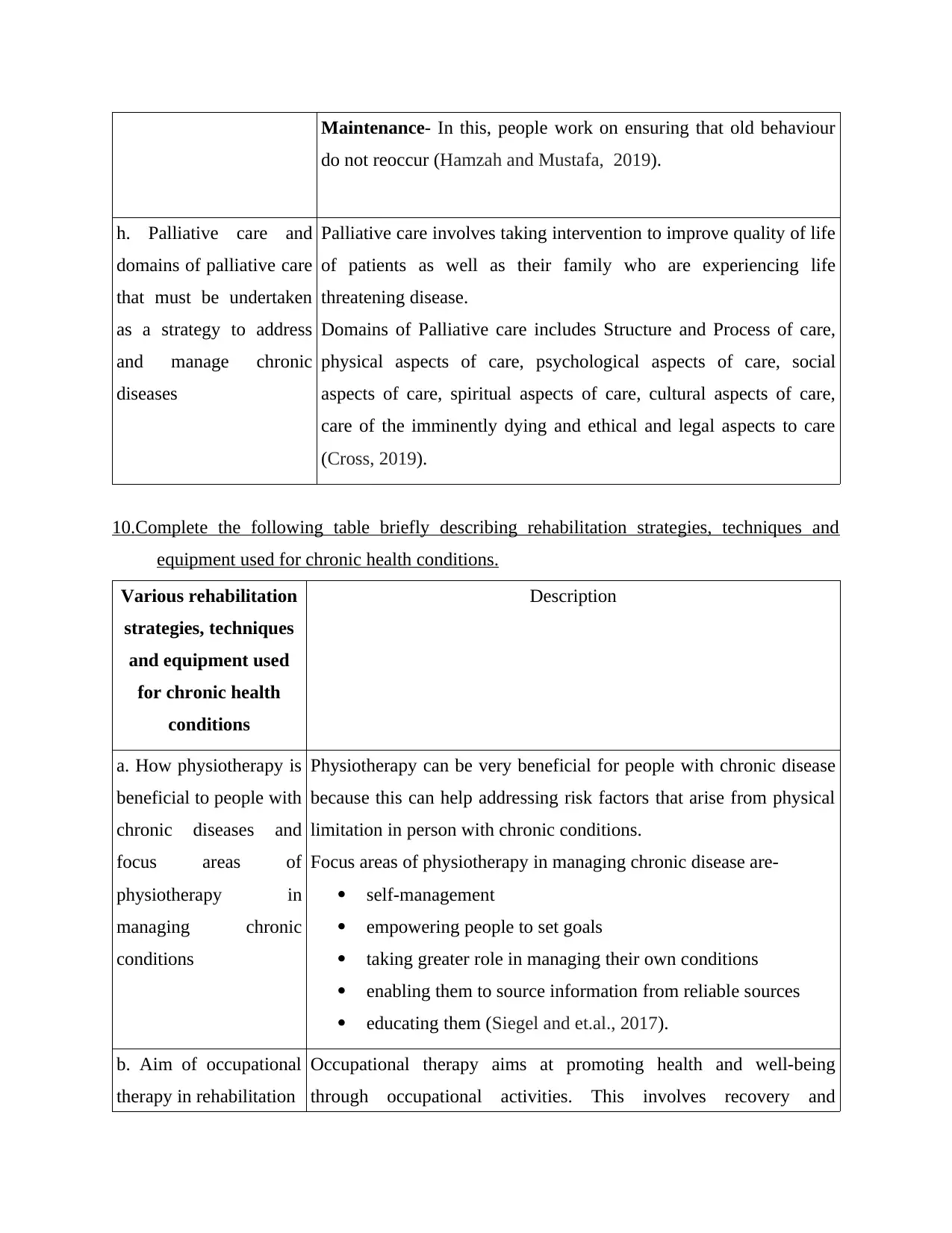
Maintenance- In this, people work on ensuring that old behaviour
do not reoccur (Hamzah and Mustafa, 2019).
h. Palliative care and
domains of palliative care
that must be undertaken
as a strategy to address
and manage chronic
diseases
Palliative care involves taking intervention to improve quality of life
of patients as well as their family who are experiencing life
threatening disease.
Domains of Palliative care includes Structure and Process of care,
physical aspects of care, psychological aspects of care, social
aspects of care, spiritual aspects of care, cultural aspects of care,
care of the imminently dying and ethical and legal aspects to care
(Cross, 2019).
10.Complete the following table briefly describing rehabilitation strategies, techniques and
equipment used for chronic health conditions.
Various rehabilitation
strategies, techniques
and equipment used
for chronic health
conditions
Description
a. How physiotherapy is
beneficial to people with
chronic diseases and
focus areas of
physiotherapy in
managing chronic
conditions
Physiotherapy can be very beneficial for people with chronic disease
because this can help addressing risk factors that arise from physical
limitation in person with chronic conditions.
Focus areas of physiotherapy in managing chronic disease are-
self-management
empowering people to set goals
taking greater role in managing their own conditions
enabling them to source information from reliable sources
educating them (Siegel and et.al., 2017).
b. Aim of occupational
therapy in rehabilitation
Occupational therapy aims at promoting health and well-being
through occupational activities. This involves recovery and
do not reoccur (Hamzah and Mustafa, 2019).
h. Palliative care and
domains of palliative care
that must be undertaken
as a strategy to address
and manage chronic
diseases
Palliative care involves taking intervention to improve quality of life
of patients as well as their family who are experiencing life
threatening disease.
Domains of Palliative care includes Structure and Process of care,
physical aspects of care, psychological aspects of care, social
aspects of care, spiritual aspects of care, cultural aspects of care,
care of the imminently dying and ethical and legal aspects to care
(Cross, 2019).
10.Complete the following table briefly describing rehabilitation strategies, techniques and
equipment used for chronic health conditions.
Various rehabilitation
strategies, techniques
and equipment used
for chronic health
conditions
Description
a. How physiotherapy is
beneficial to people with
chronic diseases and
focus areas of
physiotherapy in
managing chronic
conditions
Physiotherapy can be very beneficial for people with chronic disease
because this can help addressing risk factors that arise from physical
limitation in person with chronic conditions.
Focus areas of physiotherapy in managing chronic disease are-
self-management
empowering people to set goals
taking greater role in managing their own conditions
enabling them to source information from reliable sources
educating them (Siegel and et.al., 2017).
b. Aim of occupational
therapy in rehabilitation
Occupational therapy aims at promoting health and well-being
through occupational activities. This involves recovery and
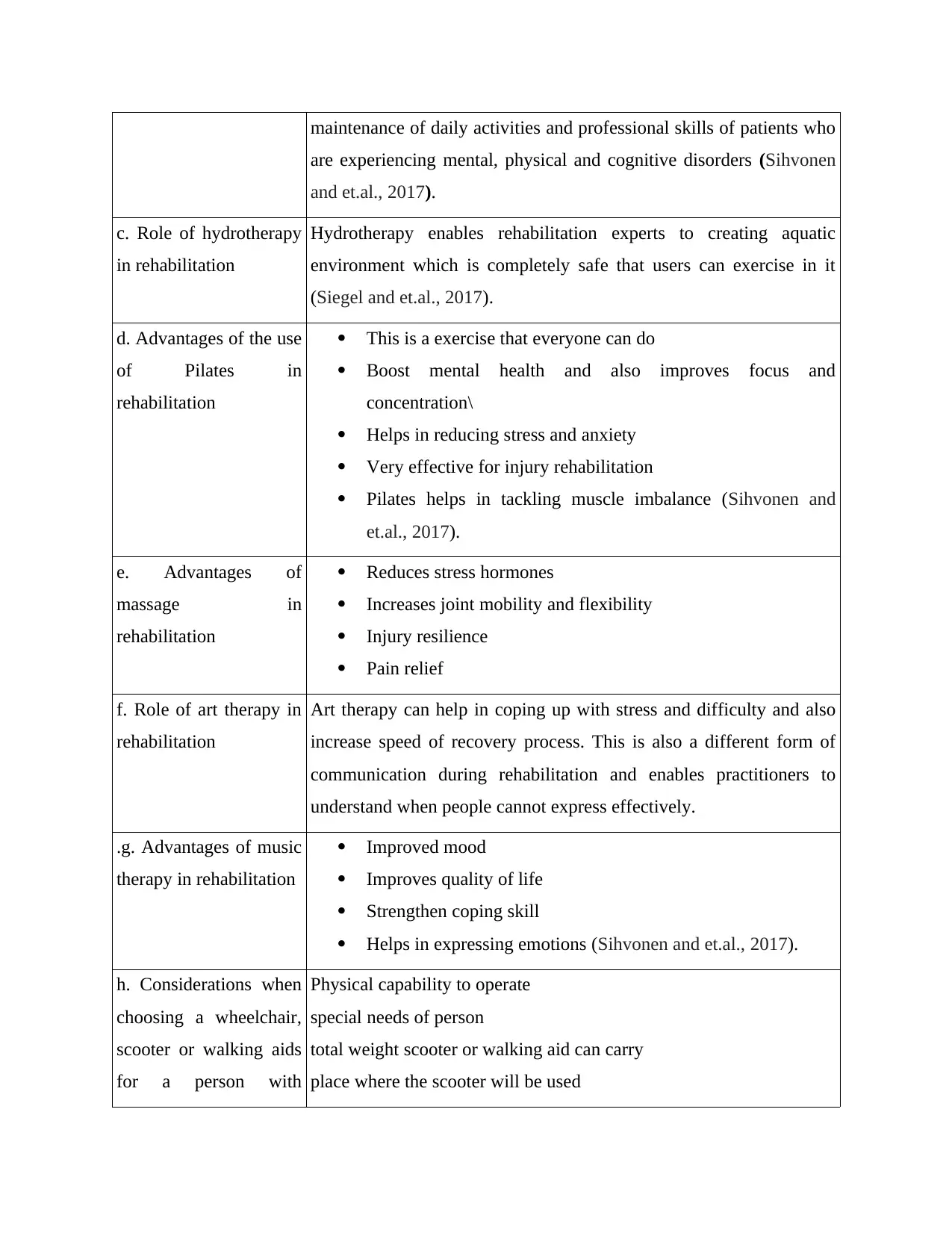
maintenance of daily activities and professional skills of patients who
are experiencing mental, physical and cognitive disorders (Sihvonen
and et.al., 2017).
c. Role of hydrotherapy
in rehabilitation
Hydrotherapy enables rehabilitation experts to creating aquatic
environment which is completely safe that users can exercise in it
(Siegel and et.al., 2017).
d. Advantages of the use
of Pilates in
rehabilitation
This is a exercise that everyone can do
Boost mental health and also improves focus and
concentration\
Helps in reducing stress and anxiety
Very effective for injury rehabilitation
Pilates helps in tackling muscle imbalance (Sihvonen and
et.al., 2017).
e. Advantages of
massage in
rehabilitation
Reduces stress hormones
Increases joint mobility and flexibility
Injury resilience
Pain relief
f. Role of art therapy in
rehabilitation
Art therapy can help in coping up with stress and difficulty and also
increase speed of recovery process. This is also a different form of
communication during rehabilitation and enables practitioners to
understand when people cannot express effectively.
.g. Advantages of music
therapy in rehabilitation
Improved mood
Improves quality of life
Strengthen coping skill
Helps in expressing emotions (Sihvonen and et.al., 2017).
h. Considerations when
choosing a wheelchair,
scooter or walking aids
for a person with
Physical capability to operate
special needs of person
total weight scooter or walking aid can carry
place where the scooter will be used
are experiencing mental, physical and cognitive disorders (Sihvonen
and et.al., 2017).
c. Role of hydrotherapy
in rehabilitation
Hydrotherapy enables rehabilitation experts to creating aquatic
environment which is completely safe that users can exercise in it
(Siegel and et.al., 2017).
d. Advantages of the use
of Pilates in
rehabilitation
This is a exercise that everyone can do
Boost mental health and also improves focus and
concentration\
Helps in reducing stress and anxiety
Very effective for injury rehabilitation
Pilates helps in tackling muscle imbalance (Sihvonen and
et.al., 2017).
e. Advantages of
massage in
rehabilitation
Reduces stress hormones
Increases joint mobility and flexibility
Injury resilience
Pain relief
f. Role of art therapy in
rehabilitation
Art therapy can help in coping up with stress and difficulty and also
increase speed of recovery process. This is also a different form of
communication during rehabilitation and enables practitioners to
understand when people cannot express effectively.
.g. Advantages of music
therapy in rehabilitation
Improved mood
Improves quality of life
Strengthen coping skill
Helps in expressing emotions (Sihvonen and et.al., 2017).
h. Considerations when
choosing a wheelchair,
scooter or walking aids
for a person with
Physical capability to operate
special needs of person
total weight scooter or walking aid can carry
place where the scooter will be used
⊘ This is a preview!⊘
Do you want full access?
Subscribe today to unlock all pages.

Trusted by 1+ million students worldwide
1 out of 16
Related Documents
Your All-in-One AI-Powered Toolkit for Academic Success.
+13062052269
info@desklib.com
Available 24*7 on WhatsApp / Email
![[object Object]](/_next/static/media/star-bottom.7253800d.svg)
Unlock your academic potential
Copyright © 2020–2025 A2Z Services. All Rights Reserved. Developed and managed by ZUCOL.




